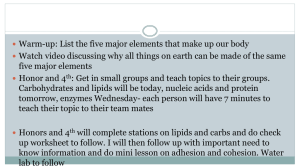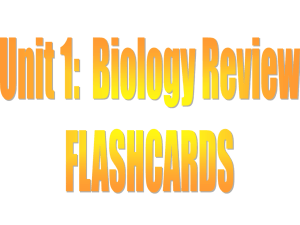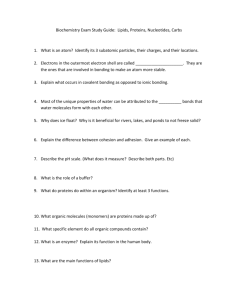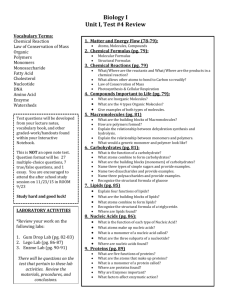catalyst unit 2: biochemistry day 1 - mshollis
advertisement
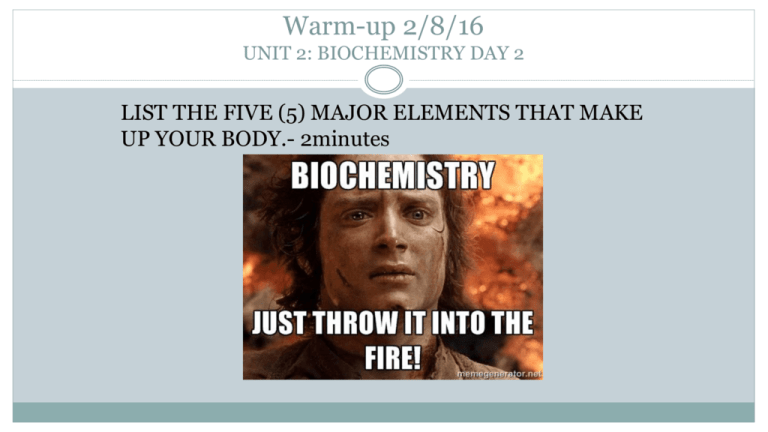
Warm-up 2/8/16 UNIT 2: BIOCHEMISTRY DAY 2 LIST THE FIVE (5) MAJOR ELEMENTS THAT MAKE UP YOUR BODY.- 2minutes Umm…why are we learning about chemistry in biology? BECAUSE….. Every biological process is part of a chemical reaction! All of the energy we need depends on chemical reactions! Why are we learning about Chemistry??? 5 elements make up over 90% of your body! C, H, N, O, P (Carbon, Hydrogen, Nitrogen, Oxygen, Phosphorous) Basic Chemistry REMINDERS… Compounds are combinations of 2 or more elements. Basic Chemistry REMINDERS… Chemical symbols are used to represent each element. Found on the Periodic Table Biochemistry Study of the chemicals necessary for living things. Also called Organic Chemistry. Involves the element carbon (C) Video 1. Get Chromebooks and log in 2. Go to class website: mshollis.cmswiki.wikispaces.net 3. Click on Biology Daily Assignments Go to 2/5/16 4. Find your groups powerpoint presentation link and open it. 5. You are the expert on your topic. You will have 5 minutes to teach your other group members who did not have your topic about your particular topic. When the timer goes off, someone else from your group will begin teaching about their particular topic. 6. Be sure to cover everything, because your peers will use this information to complete practice questions. 1. Get Chromebooks and log in 2. Go to class website: mshollis.cmswiki.wikispaces.net 3. Daily Assignments 4. Find Today’s Date: 2/8/16 Click on one of the two links and complete the Biology Crash Course Worksheet Stations You will have 8 minutes to complete each station. You DO NOT HAVE TO WRITE THE QUESTION, BUT YOU MUST WRITE YOUR ANSWER IN COMPLETE SENTENCES TO RECEIVE CREDIT After the music stops you the station guide will rotate but you will stay seated. Macromolecules Crash Course Organic vs. Inorganic Organic Molecules Contain carbon, hydrogen and oxygen atoms together Inorganic Molecules Don’t contain carbon, hydrogen and oxygen together Make up living things Make up nonliving things Molecules that play an important Molecules that also play an role in living things Most important organic molecule is glucose important role in living things Most important inorganic molecule is water. Biochemistry Terms to Know: Monomer – the smallest unit of a substance (the building block) Example: like one Lego block Polymer – many monomers linked together to make a large structure; also called macromolecules (many repeating subunits linked together) Example: Lego blocks put together to make a Lego house Biochemistry Types of Organic Molecules (Macromolecules) 1. Carbohydrates 2. Lipids 3. Proteins 4. Nucleic Acids CARBOHYDRATES Function: to store and release QUICK energy If the energy is not used, it gets stored as FAT (or LIPIDS) Monomer = monosaccharide (one unit of sugar) Examples: Glucose & Fructose Simple sugars Polymer = Polysaccharide (many Example: Starches, glycogen, cellulose Complex sugars units of sugar) The ATOMS & RATIO Made of CARBON (C), HYDROGEN (H), and OXYGEN (O) These atoms are found in a special ration: 1:2:1 ratio (Example: C6H12O6) It LOOKS Like… Monomer Pictures Polymer It is IMPORTANT because… It is made by PRODUCERS in PHOTOSYNTHESIS GLUCOSE is the sugar made by plants during photosynthesis. Animals use this glucose to help create cellular energy (ATP) TESTS FOR SUGAR: Benedict’s Solution To help remember this: BEN LIKES SUGAR! FOR STARCH: Iodine To help remember this: I DINE ON STARCH! Monosaccharides Monomer = 1 Unit of SUGAR Examples: Glucose Fructose Monomers are SIMPLE carbohydrates They give you quick energy and are typically not very healthy Example: sugars found in candy bars! POLYSACCHARIDES Polymer = Many Units of SUGAR Examples: Starch sugars in plants (made of many repeating glucose molecules) Glycogen energy storage in animal muscle Cellulose found in plant cell walls; animals can not digest Polysaccharides are COMPLEX carbohydrates They are better for you than SIMPLE carbohydrates Examples: brown rice, potatoes, pasta, bread They typically END in… -OSE Example: glucOSE, fructOSE, lactOSE Lipids FUNCTION of LIPIDS Function: Stored, long-term energy Very concentrated Twice as much energy as carbohydrates Insulation Body Padding Keeps you warm (think of the blubber on a whale!) Cushions body organs Cell membranes PhosphoLIPID Bilayer Fat surrounds all of your cells and helps support the cell Commonly called fats, oils and waxes SUBUNITS 1 GLYCEROL and 3 FATTY ACIDS Monomer = long chains of 1 glycerol and 3 fatty acids GLYCEROL 3 FATTY ACIDS The ATOMS & RATIO Made of CARBON (C), HYDROGEN (H), and OXYGEN (O) RATIO? THERE IS NO SPECIFIC RATIO!! Lipids have the same ATOMS as carbohydrates, but lipids do not have a specific ratio like carbohydrates do. It LOOKS Like… Pictures Molecular Structure of Fat not a chain (polymer) = just a “big fat molecule” glycer ol 2003-2004 fatty acid fatty acid fatty acid TESTS BROWN PAPER BAG TEST! If there IS a grease stain, then lipids are present! Saturated vs. Unsaturated UNSATURATED SATURATED • • • Saturated – bonds in molecule are UNBENDABLE Tend to clog arteries Typically from animals (fats, butter, lard) • • • Unsaturated – some bonds in molecule BENDABLE Better, but can still clog arteries Typically from plants (oils) It’s IMPORTANT for your CELLS… Cell membranes are made out of lipids phospholipids heads are on the outside touching water tails are on inside away from water 2003-2004 “like” water (hydroPHILIC) “scared” of water (hydroPHOBIC) forms a barrier between the cell & the outside Properties of Water - Observations Cohesion: Water is attracted to water Adhesion: Water is attracted to other substances *cohesion and adhesion are the "stickiness" that water molecules have for each other and for other substances *surface tension is the result of the tendency of water molecules to attract one another In a water molecule, the two hydrogen atoms align themselves along one side of the oxygen atom, with the result being that the oxygen side has a slight negative charge and the side with the hydrogen atoms has a slight positive charge. Thus when the positive side on one water molecule comes near the negative side of another water molecule, they attract each other and form a hydrogen bond. Exit Ticket Complete the Venn Diagram comparing and contrasting carbohydrates and lipids Homework due tomorrow Finish Carbohydrates and Lipids Venn Diagram- will be checked tomorrow Complete the Check-up Worksheet Copy notes on Proteins and Nucleic Acids

